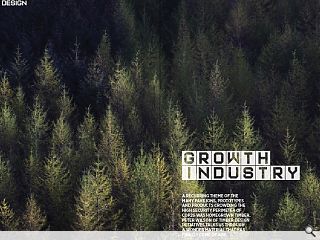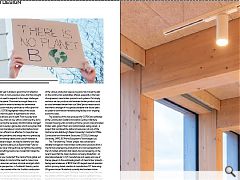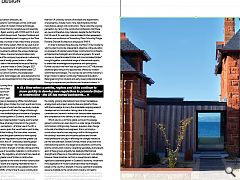Timber Design: Growth Industry
21 Jan 2022
A recurring theme of the many pavilions, prototypes and products crowding the high security perimeter of COP26 was homegrown timber. Peter Wilson of Timber Design Initiatives talks us through a wonder material that has finally come of age.
The end of a calendar year is always a good time for reflection and, perhaps more than in many previous ones, 2021 has brought to the fore the urgent need to respond to the major challenges that now confront the planet. Prominent amongst these is to review the way we build in order to redress the detrimental impacts the construction industry continues to inflict upon the global environment. COP26 highlighted many of the issues involved, but so too has two years of a pandemic for which, currently, there is no obvious end in sight. From a purely local (Scottish) perspective, what can we, within a small country, do to play our part in delivering the necessary transformative changes? The starting point is surely a game plan which recognises that much of what was commonplace in construction before Covid was neither economic, efficient nor effective.
To hope that we can come through the pandemic and simply return to previously wasteful and environmentally-destructive uses of materials is not, therefore, the place to begin: we need to identify new ways of thinking, designing and building or, as Buckminster Fuller so succinctly put it, ”You never change things by fighting the existing reality. To change something, build a new model that makes the existing model obsolete.” What might this new model be? The mantra ‘think global, act local’ comes immediately to mind and the need to make more effective use of the resources we have, principle amongst which - from a construction perspective - is Scotland’s forestry sector.
For too long a myth has existed within the Scottish construction industry that the trees grown here are unsuited to construction use. It is a myth that, in our new world circumstances, needs to be put to bed: research at Edinburgh Napier University over the past two decades into the nature of this resource and the properties of the various production species we grow has moved the dial on the construction possibilities offered, especially in the field of engineered, mass timber products and systems. Put simply, we know we can produce solid laminate timber products such as cross laminated timber from our Sitka Spruce resource and that there is enough of this species available over future years to sustain a commercial manufacturing facility on an ongoing economic basis. The evidence of this was produced for COP26 and exhibited at the Construction Scotland Innovation Centre in Blantyre: modular housing units consisting of home-grown cross laminated timber walls, glulam floors and nail laminated ceiling panels - a project that combined the skills and resources not only of the Centre but also Edinburgh Napier University’s Centre for Offsite Construction and Innovative Structures (COCIS), Edinburgh University, SNRG, BSW and Ecosystems Technologies Ltd.
This ‘Transforming Timber’ project was conceived to validate homegrown mass timber construction products from a mechanical, engineering, productivity and cost perspective for the UK market, all factors that clearly had some bearing on the recent news that the major Austrian company, Binderholz - an international leader in CLT manufacture and supply and one of the key players in the worldwide growth of mass timber projects - had agreed a takeover of BSW, the UK’s largest sawmill operator, with its primary stated intention to manufacture CLT here using UK-grown timber. Binderholz currently has fourteen timber production sites (in Austria, Germany, Finland and the USA) and the addition of BSWs eight UK sites is clearly a significant move towards more localised manufacture in one of Binderholz’s major markets and a direct consequence of concerns over the climate emergency, embodied carbon emissions, etc. Meanwhile, Ecosystems Technologies Ltd has continued to advance the production of modern timber technologies using home-grown timber from its manufacture and assembly base in Invergordon.
Again, working with COCIS and CS-IC and supported by the Scottish Government, Transport Scotland and South Lanarkshire Council development is ongoing on the ‘Near Home’ project to create a number of new mass timber products, including a novel glulam frame system, that can be used as a kit of parts to facilitate the development of self build and building in rural and island communities to address the unique challenges they face in terms of labour, transport and associated costs. Further evidence of the company’s experience in advancing the case for greater use of locally-grown timber in offsite manufacture can be seen in the remarkable house at Nedd by Mary Arnold Forster, a recent finalist in Grand Designs 2021 ‘House of the Year’. contest. Twelve offsite prefabricated CLT modules produced by Carbon Dynamic, the predecessor company to Ecosystems Technologies Ltd, were delivered to this extremely remote site and assembled to form the building’s three distinct elements.
The founder and driving force behind both companies is Matt Stevenson, a one-time fine art and sculpture graduate of the RCA who, for the past 12+ years has focused his energies on developing offsite manufactured solutions using Scottish-grown timber, the most recent (and more easily accessible) examples of which are the new study modules to be found within the grounds of Fettes College in Edinburgh. So much for the now-available physical evidence of progress in developing mass timber systems in Scotland, what are the obstacles to their wider implementation? Clearly, post-Grenfell regulatory changes have adversely impacted on the growth - and, more especially, perceptions - of timber use in the UK, a quite bizarre consequence, given that wood had no part to play in the construction of that building. At a time when countries, regions and cities around the globe continue to move quickly to change or develop new regulations to promote greater use of timber in construction, the UK - previously a leading player in the world of mass timber design - has moved several steps backwards, a position that in the light of climate change and the need to make more use of renewable materials in construction is frankly unsustainable.
The regulatory environment here needs an overhaul to support greater use of timber in construction. Brexit too has impacted on the world of timber construction in the UK, as has the recent and ongoing international rises in the cost of raw timber, both of which can be related to the fact that the UK imports 80%+ of the timber it uses in construction: an incentive if ever there was to ‘think global, act local’ and make greater use of home-grown material. A more immediate obstacle to architects and engineers making greater use of timber is the education deficit: the fact that few UK university schools of architect and departments of engineering include much, if any, teaching about timber manufacture, design and construction. There is also the ongoing perception by many in the construction professions that these are new and therefore risky materials, despite the fact that the first UK use of, for example, cross laminated timber appeared in the then new auditorium at Shrewsbury Music School by Pringle Richards Sharratt Architects as long ago as 1998-9.
In order to address these lacunae, the Mass Timber Academy was founded to provide independent, objective online education on all aspects of solid laminate timber construction for architects, architectural technologists and structural engineers. Its recent courses on dowel laminated timber and cross laminated timber* brought together a remarkable range of international experts to share their knowledge and experience with participants. Further courses in the New Year on glulam and LVL** will provide additional grounding in the opportunities offered by modern solid timber technologies. The courses are part of the Academy’s larger mission to deliver Continuing Professional Education / lifelong learning from student and early career professional level through to experienced practitioners and business owners. In the rapidly-growing international mass timber marketplace, employment and project opportunities are global for those with the knowledge to marry the remarkable ongoing research, development and innovation taking place in European universities and research centres with demonstrable experience and competence in the delivery of mass timber buildings. Which returns us to ‘think global, act local.’ Knowledge gained in practice can open doors to a wider range of possible commissions.
Acting locally, however, requires a step change in the role of architects and engineers: this is not simply a construction issue but one requiring a shift in thinking about the country’s economic and industrial policies and the role these professions can play in effecting the changes needed to join the dots between Scotland’s forest, timber production and manufacturing sectors, the design (and education) community, and the construction industry. Operating separately, as at present, each of these groups arguably has relatively little financial strength and influence on the political environment: cumulatively, however, these industries can form a powerhouse to deliver significant sustainable growth in Scotland’s economy. Investment in the application of modern advanced timber technologies based on the country’s strength in the one significant renewable resource available to the construction industry can lead to expansion of the carbon-sequestering forest sector and provide the lead needed to deliver the political objectives pronounced at COP26. It’s time for Scotland’s building design professionals to walk the walk.
|
|





